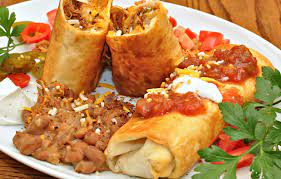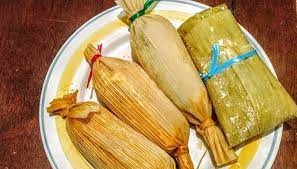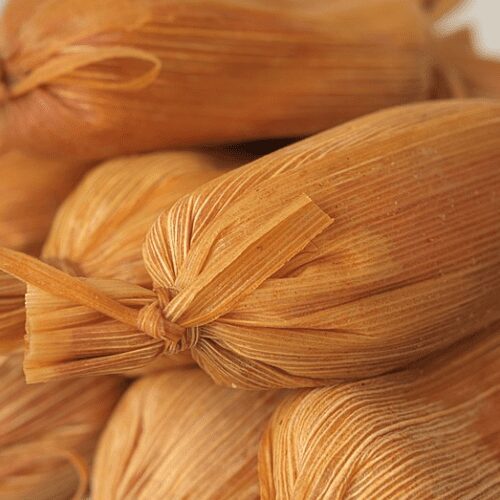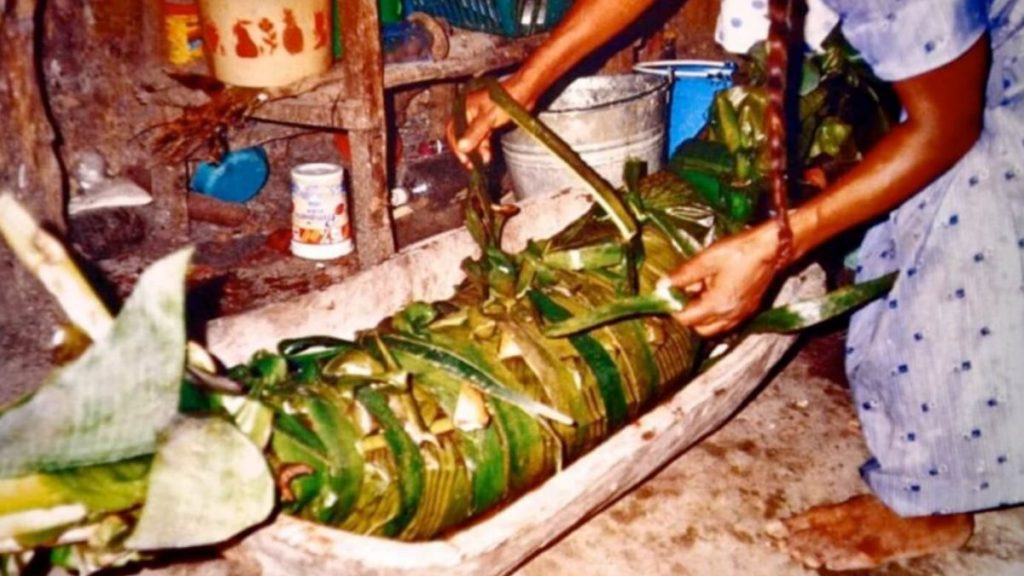ZACAHUIL and TAMALES
What is Zacahuil, and where did it originate from?
Zacahuil is a traditional Mexican dish that originated from the Huasteca region. It is a large tamale made with corn dough and filled with pork, chicken, or other meats. Zacahuil is typically cooked for special occasions and celebrations due to its size and labor-intensive preparation process.
Words like zacahuil, chimichangas, and chanchamitos are heard as something fun; however, their definition lies in dishes of Mexican gastronomy that we will take care of explaining what they are.
Mexican cuisine is full of concepts originating from the pre-Hispanic era, or it has adaptations that rescue a little of the ingredients of different localities.
Each region of Mexico has its customs and traditions, including food, which can present significant variants, although no less delicious than others.
Zacahuil
This dish is emblematic of the Huasteca region of the Mexican Republic. According to the book “Sabores de la Huasteca,” published by the Ministry of Culture, its preparation will have different variants since it depends on the customs and ingredients of each locality.
Zacahuil can be found in states such as Veracruz, San Luis Potosí, Tamaulipas, Querétaro, Puebla and Hidalgo.
According to the recipes of the book “Sabores de la Huateca,” zacahuil is a tamal wrapped with more than 30 banana leaves and is very large, so it can be served in portions to share with many people.
Despite the variants of zacahuil by region, it usually contains almost 10 kilos of pork or chicken meat, plus 6 kilos of nixtamalized maize.
The recipes also have different combinations of spices, including cloves, cumin, garlic, salt, and pepper, lard; season the meat with a sauce of Chinese chiles or guajillo chili, ancho chili, and cinnamon is prepared.
Zacahuil is prepared a day in advance before eating. It is customary to cook this large dish in a clay oven where the banana leaves are assembled, and then the corn with butter and meat is added.
Zacahuil Preparation
In a mud oven, its cooking takes twelve hours. The process begins with preparing 10 kilos of dough in a pot where you put the broken nixtamal (mass), baking soda, salt, kilo, and a half of pork butter, and start the smoothie with your hand, which requires a significant physical effort.
Already having an acceptable consistency, the sauce is added made with a mixture of one kilo of rattlesnake, garlic, cloves, cumin, pepper, and about 7 liters of water are poured and then re-kneaded for several minutes until the mixture is watery.
It is then deposited in a punt or mud mold (currently can and plastic bag) greased with butter and lined with leaves from the previously roasted banana plant.
Separately, three kilos of meat were previously prepared in a bowl of water, salt, onion, pepper, garlic, and a quarter of rattlesnake.
After fully impregnating, the seasonings are placed in the pan where the dough is already ready; it is covered and tied with wire to be put into the oven at night; there, it is sealed with branches and Zacate that retain the heat of the wood and is removed the following day.
The community zacahuil or large tamal is from the Huasteca area; today formed or even “claimed” by Hidalgo, Veracruz, Tamaulipas, San Luis Potosí, Puebla, and Querétaro, where pre-Hispanic food is prepared for traditional use, albeit with slight variants.
The custom is to serve it on a plate on top of a roasted banana leaf; some diners accompany it with jalapeño chiles, pickled vegetables, pork strains, and coffee Pot.
There are varieties of zacahuil that integrate sweet piloncillo or honey from bees and are known as Chocol.
In pre-Hispanic times giant tamales were made with wild boar meat, deer, pheasant, quail, armadillo, and viper.
Chimichanga
According to information from the Take-Away English cooking site, a chimichanga is a dish derived from the burrito. According to the diner’s taste, it is a wheat or corn tortilla rolled, fried, and stuffed with the preparation of meat, beans, tomato, and spices.
Take Away notes that this dish is part of the fast food consumed in the southwestern United States and results from a combination of Texan and Mexican food.
It is also explained that the word chimichanga arises from the difficulty of Americans to asking “what is it called?” referring to the dish served to them.
Some Mexican recipes suggest that this dish is also consumed in northern Mexican states, such as Sonora, Baja California, Sinaloa, and Chihuahua. They are prepared with different recipes and are recognized for their versatility.
Chimichanga Recipe
Since I prefer not to deep-fat fry, I was attracted to this adaptation of the popular chimichanga from the chapter on Tortilla an Masa Specialties.
I had to look up other recipes to use the ricotta cheese since you must buy a 15-ounce carton (nearly two c.) to get the half cup needed here.
And I opted for all-fruit apricot preserves, which had lots of nice chunks of fruit in it. Next time, I’ll simplify the sauce by thinning the preserves with white wine and seasoning them with a dash of Worcestershire – skip the extra apricots and the honey in the basting sauce.
Fruit Chimichangas Apricot Basting Sauce (recipe follows)

Fruit Chimichangas Apricot Basting Sauce
Ingredients
- 1 8-oz. pkg. cream cheese softened
- 1/2 c. ricotta cheese
- 1/4 c. sugar
- 1 tsp. grated orange peel
- 6 flour tortillas 8-inch size, warmed#
- 1/4 c. apricot preserves
- 1 egg beaten
- 2 tbsp. margarine or butter softened
- 1 c. sliced apricots
Apricot Basting Sauce
- 1/2 cup apricot preserves
- 1/4 cup dried apricots, finely chopped
- 1/4 cup dry white wine
- 1 tbsp honey
- 1 tsp Worcestershire sauce
Instructions
- Prepare Basting Sauce; reserve.
- Heat oven to 500 degrees.
- Mix cream cheese, ricotta cheese, sugar, and orange peel thoroughly.
- Spoon about 1/4 c. mixture in center of each tortilla:
- top up with 1 tbsp.
- Preserves.
- Fold 1 edge of tortilla up about 1 inch over mixture: fold both left and right sides over already folded end, overlapping.
- Fold left end down:
- brush sides with egg to seal.
- Flick each chimichanga with margarine.
- Put seam sides down in an ungreased jelly roll pan, 15- by 10 inches.
- Bake until chimichangas begin to brown and filling is hot, 8 to 10 minutes.
- Serve with apricots and Basting Sauce.
Notes
Nutrition
Chanchamitos
The chanchamitos are small tamales that, according to information from the Encyclopedic Dictionary of Mexican Gastronomy, are prepared with lard and a broth red with achiote, in addition to having a filling of pork or chicken.
The filling of the chanchamitos is prepared with ancho chili and spices. In the end, the chanchamitos are wrapped in corn leaves or banana leaves.
These tamales are characteristic of states such as Yucatan, Tabasco, Veracruz and Campeche.

Chanchamitos Recipe

VEGETARIAN CHANCHAMITOS
Equipment
- large frying pan
- Blender
Ingredients
- 20 corn leaves
- 2 tablespoons olive oil
- 1 cup carrot peeled and diced
- 1 cup green pepper seedless diced into cubes
- 1/4 cup chopped onion
- 1 chopped garlic clove
- 1/4 teaspoon olives
- 1 1/2 cup chopped tomato
- 1 cup chopped mushrooms
- 1/2 cup quinoa
- 1 teaspoon bone SEO
- 1 teaspoon salt
- 1/4 teaspoon ground pepper
- 1 kilo of dough
- 1/2 kilo of mashed potatoes
- 350 grams of melted butter
- 1 tablespoon of salt
Instructions
- Clean and wash corn leaves.
- Soak for an hour in hot water and then drain.
- In a large frying pan, fry in olive oil for five minutes,
- fry the carrots, peppers, onions, and garlic.
- After some time incorporate the tomato, olives and cook for two more minutes.
- Finally, add the mushrooms, quinoa and season with oregano, salt, and pepper.
- Cook over medium heat for five minutes, then remove from heat and leave to cool.
- In a recent add the dough, mashed potatoes, melted butter, and salt.
- Knead for eight minutes; you can help with a blender.
- Forge the tamales by spreading some of the dough on each sheet of tamal,
- place some of the fillings, close the tamal, and place in a steamer, which was previously put water and salt, to the level that indicates it.
- Cook for 1 hour, let stand 15 minutes before serving.
- Pack with guacamole.
Nutrition
Final Words
In delving into the rich tapestry of Mexico’s culinary heritage, one can’t overlook the zacahuil tamale, a veritable tribute to the region’s indigenous roots. Originating from the Huastec region, specifically in the states of San Luis Potosi and Queretaro, this mammoth dish is a testament to when recipes were passed down orally in the Nahuatl language.
Recounting my first time trying this delicacy in the heart of Mexico City, I was fascinated by its preparation involving firewood, a staple in authentic zacahuil creation, which imparts a distinct smoky flavor, unlike the everyday use of baking powder seen in more modern recipes.
It’s more than just a meal; in traditional settings, zacahuil tamales are essential in celebrations, notably baptisms, where families gather to partake in this communal dish.
As I pen this on my blog, I want to extend a heartfelt “buen provecho” to all who venture to explore and appreciate the depths of Mexico’s gastronomic wonders.























